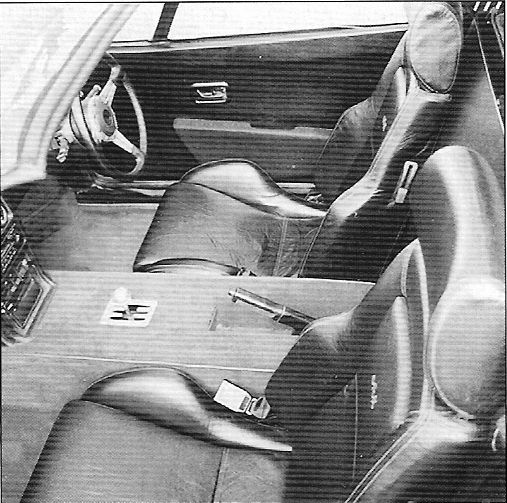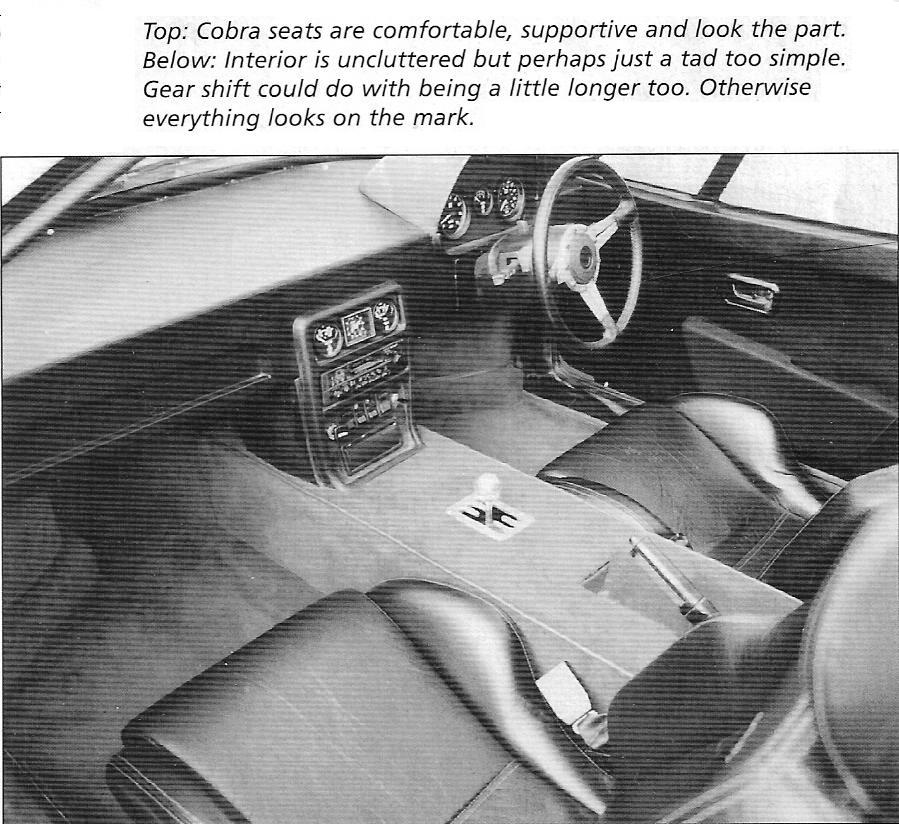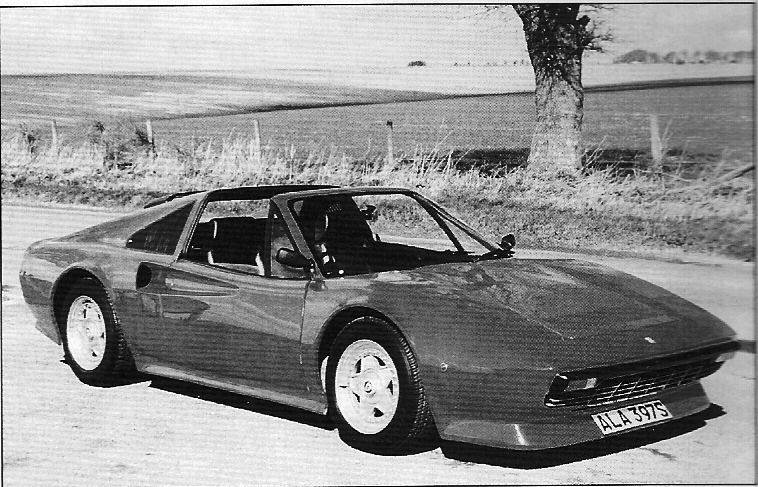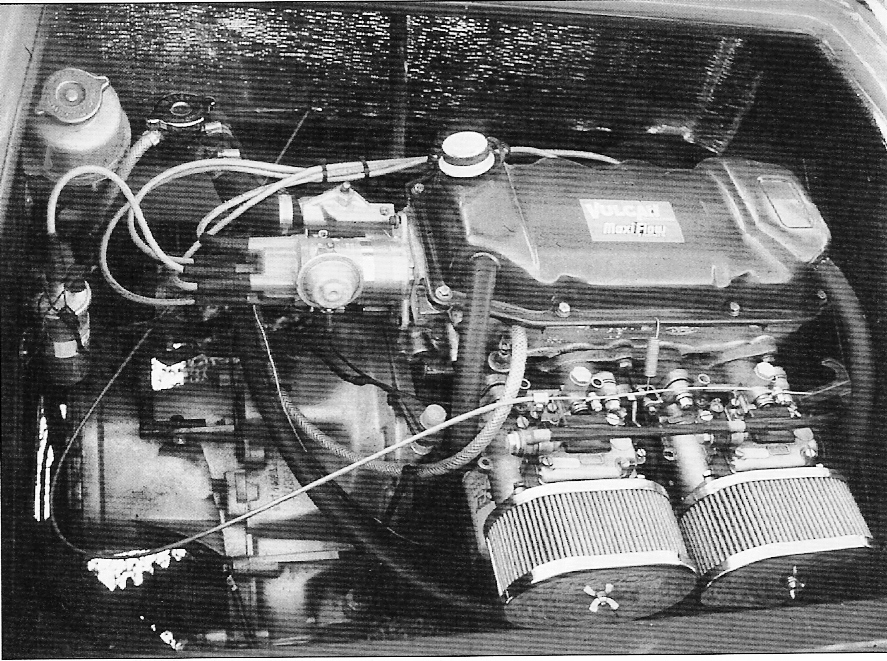Four year after buying the Lancia based Quadriga from what remained of Pace Cars, Vic Minay of Stardust D-Type fame is finally in a position to launch the Ford based Auto Milan. Whilst he didn't intend to completely redevelop the original Ferrari inspired replica, that exactly what he's ended up doing. Absolutely nothing remains of that original kit - from the chassis upwards we're talking brand new product.
But why go to such lengths in the first place7Anyone who witnessed his D-Type project might be able to answer that one for you. Whilst Vic wasn't overly concerned with producing an exact replica of the original Jaguar, getting it to look right was of paramount importance and was why he had an aluminium body made up from which he then took a fibreglass mould. Doing the job this way meant you could see the rivets in the resulting GRP panels running along the bodywork at just the right points to give that period feel. So sharp was the definition of these rivets, that you would almost swear the car was made of metal. So going the full distance to achieve a desired result isn't exactly new to Vic and is the reason the new car has had such a long gestation period.
 Following another example made by the D-Type, the Auto Milan has resisted the temptation to use expensive donor components and instead once again looks to the Ford stable for inspiration. Predominantly Mk3 Escort based, the new Milan also uses Sierra front suspension and braking components, but neither is likely to break the bank yet both can provide surprisingly effective underpinnings for such an unquestionably exotic external design.
Following another example made by the D-Type, the Auto Milan has resisted the temptation to use expensive donor components and instead once again looks to the Ford stable for inspiration. Predominantly Mk3 Escort based, the new Milan also uses Sierra front suspension and braking components, but neither is likely to break the bank yet both can provide surprisingly effective underpinnings for such an unquestionably exotic external design.
Basis for the project is an extremely substantial looking chassis which is a mix of backbone and perimeter frame with rear engine cage and front strut towers. It comes complete with equally substantial front and rear bulkhead supports, the former also playing host to the heavy duty door hinges. At the front end the Sierra suspension is left largely unmolested save for a Leda micro-strut replacing the more cumbersome Ford original. The Sierra front disc brakes also give a variety of performance options from the standard disc and caliper right up to the Cosworth 4-pot vented items - using the Ford parts begins to make some sense, doesn't it?
At the back the Ford Escort Mk3 donor car begins to make its presence felt. Whilst the Milan clearly isn't a single donor car, it does seem likely that you'll be looking to buy an XR3 for the basis of your project. Whilst it provides the engine and rear suspension for the Milan, you'll also be using all manner of smaller items, such as the steering column and its switches, door winding mechanisms and latches etc.
Not surprisingly, this is another example of where the whole front engine, transmission and suspension has been taken from the front" of a production car and relocated in the back of a kit car to give a typical mid-engined layout. A specially fabricated tie-bar locks the wheels in the desired direction, giving adjustment for toe-in, and another Leda micro-strut takes over from the Escort's original. More Ford disc brakes once again offer a variety of tuning potential so it's clear that the Milan's braking can be carefully tailored to the final engine installation.
In this first prototype that means a Vulcan prepared version of the donor's CVH. Mildly tweaked and with the addition of twin 40 Dellortos, this fully rebuilt unit is good for 125bhp and can be yours for just £1350 + VAT (on exchange) That seems pretty fine value for a fully reconditioned and tuned engine although those on a tight budget can retain the standard XR3 lump if they choose. However, using the injected XR3i engine will introduce a number of complications, not least of which is headroom under the rear engine cover - not impossible but neither is it straightforward.
Serious performance addicts will no doubt look towards the Ford 2.9litre V6 engine which pumps out around 150bhp in standard tune but can be bored out to a massive 3.7litres by the likes of Power Engineering, in Uxbridge, to produce a thumping 200+ bhp of pure adrenalin. With 240ftJlbs of torque to add to the excitement, this conversion really does pack a punch but it'll also burn a whole in your pocket with equal brutality. Stick with the standard V6 for slightly more sanitised and affordable fun. It should also make a terrific noise, which all adds to the Milan's obvious drama. As we go to press, the company is also looking at the Alfa V6 as an engine option.
For the serious Ford engine conversion you'll be using an RS Turbo gearbox but for the more ordinary CVH the Escort's 5speed gearbox is retained. The XR3 donor will also provide the electric window winder mechanisms and switches seen here on the demo car. A full compliment of column stalk controls are always welcome and the cut down plastic cowling for the column looks quite at home in its new surroundings.
Special Auto Milan fabrications include the pedal box and new front mounted radiator to keep all the shenanigans going on behind you under control. You'll also need one of the company's specially made wiring looms unless you want to modify the donor's and the side windows and windscreen are also specially made items.
The bodywork is fabricated completely from fibreglass and whilst the complete body kit sounds expensive at £3950 it includes a huge number of mouldings for the dashboard, centre console and many other less obvious parts on top of the more obvious doors, boot, engine cover, bonnet and headlights mouldings.
All of the main body panels have return edges, which is a good sign as it means panel shutlines cannot easily be altered and must be made accurately in the first place. On this first demo car the fit and finish of all bodywork it right on the button, with even shuts around everything from the headlights to the curving boot lid.
The targa roof section is clearly a major feature of the Milan, and it can be quickly removed and stored on its edge behind the seats. In this way you'll not lose any valuable storage space in the quite promising boot area, although there is a slight price to pay in terms of ultimate rearward adjustment of the driver's seat.
With the roof removed, getting into the Milan isn’t a problem. The doors feel solid and open and close with production car assurance. The leather trimmed Cobra seats are also absolutely spot on and the red stitching ties in neatly with the Italian inspiration behind the bodywork.
Pedals are typically offset to the centre, forced inwards by the inner front wheelarches and the forward driving position of any mid-engined sportscar. It’s something you very quickly get accustomed to and the Milan’s other main controls soon become familiar territory. The gearstick is perhaps just too short and this driver would have benefitted from the extra inch or so of rearward seat adjustment had the targa section not been stowed, but apart from these minor irritations things were looking distinctly promising .
A leather-bound Moto Lita steering wheel is always a delight to use and the simple uncluttered dash and interior trim does little to distract you from the task at hand. Harking back to the theory behind the original aluminium D-Type shell, Vic Minay has taken a dash moulding from a leather trimmed dashboard and few would spot that this car’s dashboard is simply a GRP moulding. Those eagle eyed amongst you that can’t quite live with the deception can always opt for the real thing or even the Italian’s favourite trim material, Alcantara (Fake Suede to you and me!)
Fire up the Ford 4-cylinder CVH engine and few would be expecting anything to sound very promising, but the deceptively simple exhaust on this car does a miraculous job of giving the 4-pot lump a distinctly exotic feel. The Milan sounds deep, smooth and purposeful at tickover and town driving speeds. In fact, so cunning is the charade that only the diehard Ferrari aficionado is likely to tell the difference. A quite remarkable feat by any standards.
The aluminium gearlever gate is simply de rigueur in such a machine as this yet they always seem to take a moment to get used to by comparison to the typically vague gear shift of your average hatch back. Stick the donor XR3’s gearstick somewhere in the direction of first gear and the chances are you’ll get it, but with the shining aluminium gate of this car there are no such vagaries. You click clack your way up the ‘box in typically dramatic fashion and it all adds to the sense of occasion. An inch or two extra on the gearstick would have made life a little easier but otherwise the shift was quite positive by mid-engined standards.
Less pleasing was the desperately tall gearing of the 5speed gearbox, forced on it by the fitment of 15” alloys with 60 series tyres. Fifth gear was a luxury rarely sampled on our brief sortie, while many corners forced us down into second gear where normally one would be powering through in third. Vic Minay’s well aware of the situation and talks with a local gearbox specialist have revealed that it is possible to change a cog in the gearbox which will bring the gearing back down to a more sensible level.
This tall gearing also had the effect of taking the edge off what is clearly an otherwise impressive Vulcan engine. But despite these problems the CVH still pulled strongly and rewed freely. With the Milan’s remarkably light weight, all of the Vulcan unit’s 125bhp can be put to good use and it soon becomes apparent that the car is anything but a slouch.
Ride in this first demonstrator is impressive and in-line with the cars sporting/touring pretensions. It sets a good balance between firm cornering and supple bump absorption while some re-rated rear springs destined for production versions should improve matters still further At present the adjustable Ledas are set to their softest setting and a couple of clicks up would probably be ideal for the open back roads around Auto Milan’s Wiltshire base.
Handling with this car is also impressive, with a really level cornering attitude and confident road feel. The steering might just lack the ultimate levels of feel associated with small sevenesque blasters, but it nonetheless dials in the driver’s instructions with precision and without unwanted drama.
Hardly a surprise that the disc brakes on each corner call a halt to any unwanted speed in pretty short order and without fuss.
This car’s prototype status was evident in a number of small areas, with odd interior trim pieces still to sort properly and a few panels still requiring rubber stops to knock out unwanted rattles. But in reality there was little here that a few moments’ fettling wouldn’t have put right and this early outing for the car was overwhelmingly positive. Not least for the success of the Ford components as suitable underpinnings for such an otherwise exotic machine.
Externally, only the experienced eye would spot the detail differences over an original Italian Stallion while we defy anyone to guess the donor just by looking at it or even driving it
The real plus point to this is in the obvious affordability of such components over more expensive parts. XR3 donor cars are often embarrassingly cheap, even when they come with a useful MoT, while the few Sierra components can be quickly acquired from your local breakers for minimal expense and zero aggro. So just how much is a Milan likely to set you back .. ?
As we’ve already mentioned, the comprehensive Body package comes in at £3950 and a Chassis pack, including all fabricated components such as the pedal box comes in at a further £1495. The bottom line for a completed Milan would seem to be in the region of £8000, while an example of comparable presentation to the demo car could be nearer the £10,000 mark. That’s certainly not bad value and places the car firmly at the more affordable end of similar Fiero conversions. Many will prefer the Auto Milan’s more conventional kit car construction while few could argue with the availability and value of parts.












 Ferrari 308 GTS Replica
Ferrari 308 GTS Replica





 Following another example made by the D-Type, the Auto Milan has resisted the temptation to use expensive donor components and instead once again looks to the Ford stable for inspiration. Predominantly Mk3 Escort based, the new Milan also uses Sierra front suspension and braking components, but neither is likely to break the bank yet both can provide surprisingly effective underpinnings for such an unquestionably exotic external design.
Following another example made by the D-Type, the Auto Milan has resisted the temptation to use expensive donor components and instead once again looks to the Ford stable for inspiration. Predominantly Mk3 Escort based, the new Milan also uses Sierra front suspension and braking components, but neither is likely to break the bank yet both can provide surprisingly effective underpinnings for such an unquestionably exotic external design.

